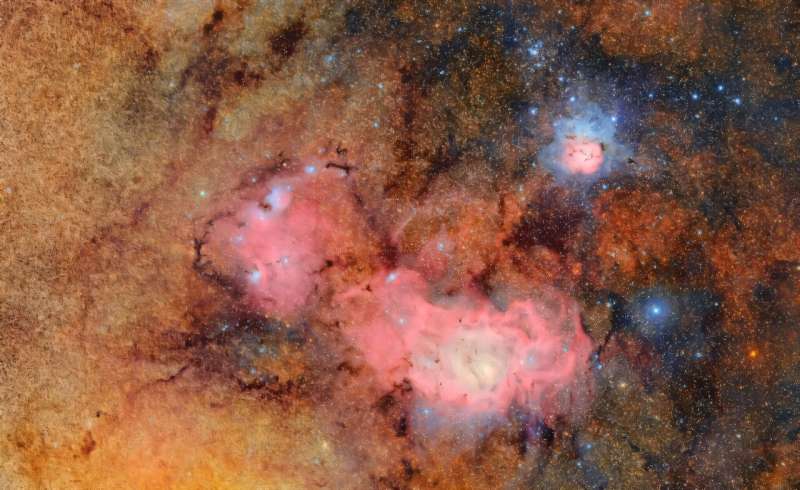News Flash
News Flash

WASHINGTON, June 23, 2025 (BSS/AFP) - Breathtaking, swirling, multicolored
galaxies and star-forming regions were revealed Monday in the first images of
deep space captured by the Vera Rubin Observatory in Chile.
More than two decades in the making, the giant US-funded telescope sits
perched at the summit of Cerro Pachon in central Chile, where dark skies and
dry air provide ideal conditions for observing the cosmos.
One of the debut images is a composite of 678 exposures taken over seven
hours, capturing the Trifid Nebula and the Lagoon Nebula -- both several
thousand light-years from Earth -- glowing in vivid pinks against orange-red
backdrops.
The image reveals these stellar nurseries within our Milky Way in
unprecedented detail, with previously faint or invisible features now clearly
visible.
Another image offers a sweeping view of the Virgo Cluster of galaxies.
The team also released a video dubbed the "cosmic treasure chest," which
begins with a close-up of two galaxies before zooming out to reveal
approximately 10 million more.
"The Rubin Observatory is an investment in our future, which will lay down a
cornerstone of knowledge today on which our children will proudly build
tomorrow," said Michael Kratsios, director of the White House Office of
Science and Technology Policy.
It features an advanced 8.4-meter telescope and the largest digital camera
ever built, supported by a powerful data-processing system.
Roughly the size of a car and weighing 2.8 tons, the camera captures 3,200-
megapixel images -- more than three times the resolution of the next most
powerful instrument, Japan's Hyper Suprime-Cam, which records at 870
megapixels.
- 10-year flagship project -
Later this year, the observatory will begin its flagship project, the Legacy
Survey of Space and Time (LSST). Over the next decade, it will scan the night
sky nightly, capturing even the subtlest visible changes with unmatched
precision.
The observatory, which cost roughly $800 million, is named after pioneering
American astronomer Vera C. Rubin, whose research provided the first
conclusive evidence for the existence of dark matter -- a mysterious
substance that does not emit light but exerts gravitational influence on
galaxies.
Dark energy refers to the equally mysterious and immensely powerful force
believed to be driving the accelerating expansion of the universe. Together,
dark matter and dark energy are thought to make up 95 percent of the cosmos,
yet their true nature remains unknown.
The observatory, a joint initiative of the US National Science Foundation and
Department of Energy, has also been hailed as one of the most powerful tools
ever built for tracking asteroids.
In just 10 hours of observations, the Rubin Observatory discovered 2,104
previously undetected asteroids in our solar system, including seven near-
Earth objects -- all of which pose no threat.
For comparison, all other ground- and space-based observatories combined
discover about 20,000 new asteroids per year.
Rubin is also set to be the most effective observatory at spotting
interstellar objects passing through the solar system.
More images from the observatory were expected to be released later Monday.
- Chilean pride -
Chile hosts telescopes from more than 30 countries, including some of the
world's most powerful astronomical instruments -- among them the ALMA
Observatory, the most advanced radio telescope on Earth.
The upcoming Extremely Large Telescope, slated to begin operations in 2027,
will enable observations of previously unreachable cosmic distances.
Northern Chile's deserts, nestled between the Pacific Ocean and the Andes
mountains, offer the clearest skies on the planet, thanks to minimal cloud
cover and an arid climate.
The Cerro Tololo Observatory has been the site of major discoveries,
including the universe's accelerated expansion -- a breakthrough that earned
Americans Saul Perlmutter and Adam Riess, along with Australian Brian
Schmidt, the 2011 Nobel Prize in Physics.